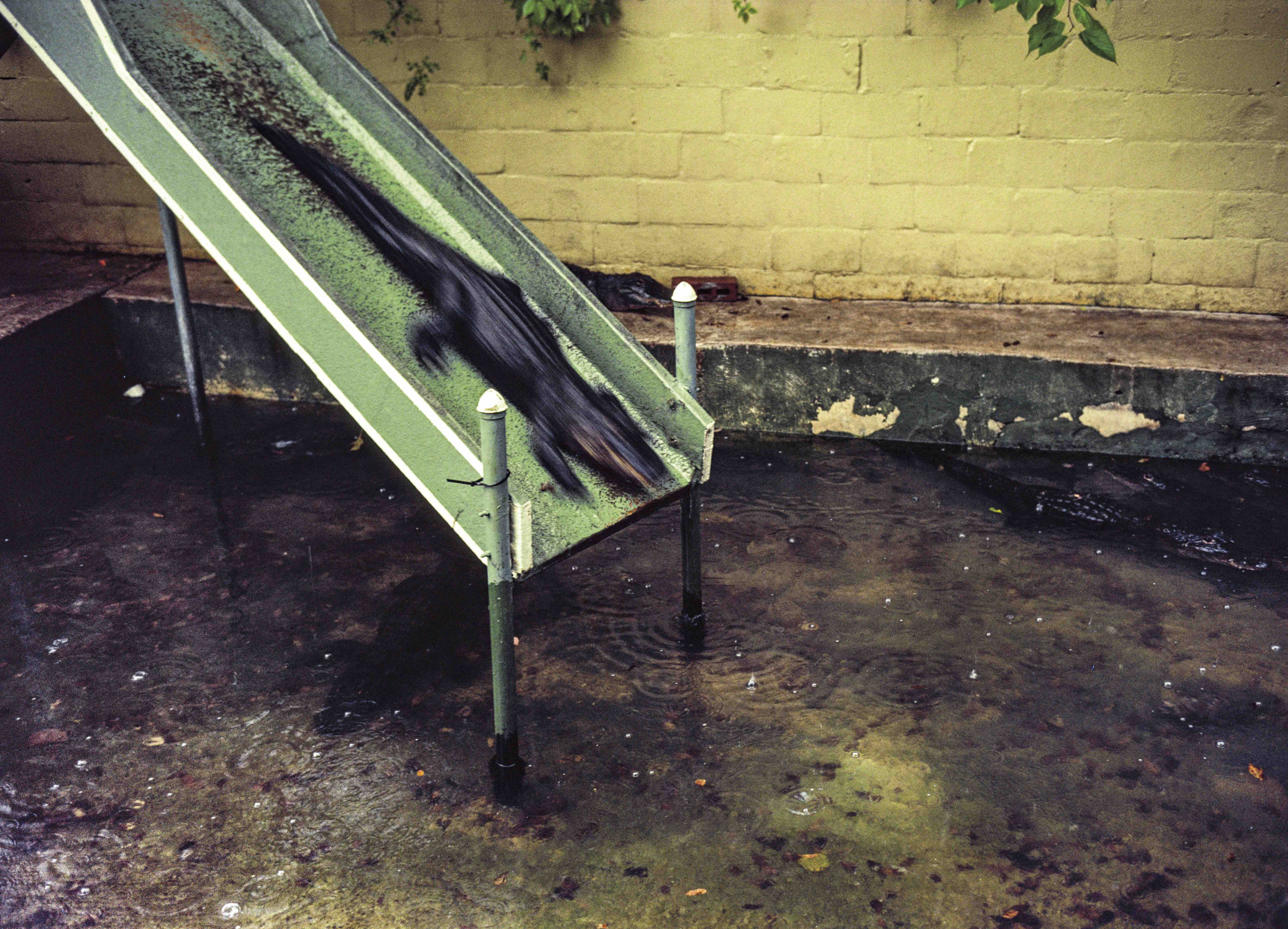Documenting the dark side of ’80s Florida
- Text by Miss Rosen
- Photography by Nathan Benn

The image of Florida is a curious mélange of palm trees and sandy beaches, gators and golfers on the green, and something darker lying in wait, ready to take the bait — best known to in the headlines as “Florida Man.” Peel back the cheerful veneer of “the happiest place on earth,” and what you find is something far more unusual.
Perhaps it is the draw of living in the Sunshine State that has cast Florida as the dream destination for people living across the Americas. “Whether they were snowbirds moving from the north into retirement or whether they were refugees, economic or political, from the Caribbean, Florida has always had this allure as a place of opportunity,” says Florida native Nathan Benn, who is showing photographs from his new book A Peculiar Paradise (powerHouse) at HistoryMiami Museum this winter.

Krome Detention Center, West Miami

Haitian refugees attempt to immigrate, Biscayne Bay, Miami.
“This is not like any other celebration of the state: other Florida picture books have sunsets, palm trees and beaches, and pink stucco,” Benn adds. Here, we have everything from Dundee’s 5th Street Gym, where Muhammad Ali famously trained, to Benn’s work with Frank White (a.k.a. “Dirty Harry”) at the Drug Enforcement Agency during the early days of the Drug War.
Drawing from an archive of more than 27,000 photographs taken of his home state while photographing for National Geographic Magazine over a period of 20 years, A Peculiar Paradise is a love letter to a most unusual land.
“When I was growing up in the ’50s and ‘60s, Miami was considered very different from the rest of the state but it really wasn’t,” the photographer remembers. “Miami was a white town. In 1950, the year I was born, it was 84 per cent Anglo-white, 16 per cent Black, and 0 per cent Latinx. Today, South Florida, two-thirds of the population is Latinx.”

Bal des Arts gala, Breakers Hotel, Palm Beach.

Humberto Alvarcado teaches guerilla tactics at Alpha 66 training camp, dedicated to overthrow the Castro regime and return to Free Cuba, Homestead, 1981
“When I was 18 year old, I started interning at the Miami News, and I learned a lot. But I also knew that Florida was in a very provincial place and I wanted to get out as fast as I could. As soon as I picked up my diploma from the University of Miami in 1972, I headed to Washington. I graduated on a Monday night and started work on Wednesday morning for National Geographic.”
But the move couldn’t keep Benn away. In 1981, he embarked on a year-long assignment to document Florida for the Geographic, creating a complex, nuanced, and multi-faceted view of the state from the eyes of one who knows it well.
In Benn’s Florida, we delve into the deeper stories of the people who call the state home. We witness the arrival of Cuban immigrants and the refugee boats coming in from Haiti, and the enduring xenophobia from Caucasians who embodied the ethos of the Confederacy, more than a century after it fell. We see the radical polarisation between Left and Right, an ongoing reminder that the seeds of nation’s current political climate were planted a very long time ago.

Sugar cane cutters from Jamaica prepare to go home after harvest season, Miami International Airport

Visitor parking at Kennedy Space Center, Cape Canaveral.

Gatorland, St. Augustine

Gatorland, St. Augustine.

Fountainbleau Hotel, Miami Beach

Sully Emmett collected the gym’s membership dues. 5th Street Gym, Miami Beach, 1981.

Spraying mosquito control insecticide from DC-3s, Collier County.
A Peculiar Paradise: Florida Photographs by Nathan Benn is on view at HistoryMiami Museum through April 14, 2019.
Follow Miss Rosen on Twitter.
Enjoyed this article? Like Huck on Facebook or follow us on Twitter.
Latest on Huck

From his skating past to sculpting present, Arran Gregory revels in the organic
Sensing Earth Space — Having risen to prominence as an affiliate of Wayward Gallery and Slam City Skates, the shredder turned artist creates unique, temporal pieces out of earthly materials. Dorrell Merritt caught up with him to find out more about his creative process.
Written by: Dorrell Merritt

In Bristol, pub singers are keeping an age-old tradition alive
Ballads, backing tracks, beers — Bar closures, karaoke and jukeboxes have eroded a form of live music that was once an evening staple, but on the fringes of the southwest’s biggest city, a committed circuit remains.
Written by: Fred Dodgson

This new photobook celebrates the long history of queer photography
Calling the Shots — Curated by Zorian Clayton, it features the work of several groundbreaking artists including Robert Mapplethorpe, Sunil Gupta, Zanele Muholi and more.
Written by: Miss Rosen

Krept & Konan: “Being tough is indoctrinated into us”
Daddy Issues — In the latest from our interview column exploring fatherhood and masculinity, UK rap’s most successful double act reflect on loss, being vulnerable in their music, and how having a daughter has got Krept doing things he’d never have imagined.
Written by: Robert Kazandjian

Vibrant polaroids of New York’s ’80s party scene
Camera Girl — After stumbling across a newspaper advert in 1980, Sharon Smith became one of the city’s most prolific nightlife photographers. Her new book revisits the array of stars and characters who frequented its most legendary clubs.
Written by: Miss Rosen

Bad Bunny: “People don’t know basic things about our country”
Reggaeton & Resistance — Topping the charts to kick off 2025, the Latin superstar is using his platform and music to spotlight the Puerto Rican cause on the global stage.
Written by: Catherine Jones